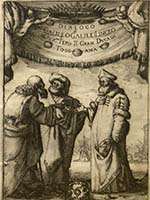July Highlight - Faculty Choice
 Champions Copernican System
Champions Copernican System
Galileo Galilei, 1564-1642. Dialogo di Galileo Galilei Linceo matematico sopraordinario dello stvdio di Pisa. Florence, Landini, 1632.
Galileo’s Dialogue Concerning the Two Chief World Systems compares the Copernican system with the traditional Ptolemaic system.
In September 1610, using his 3x refracting telescope (later improved to 30x), Galileo observed that Venus exhibited a full set of phases similar to that of the moon. Copernicus’ heliocentric model of the solar system predicted this. However, the Inquisition concluded in 1615 that heliocentrism was false and contrary to scripture, and works advocating the Copernican system were banned. In 1632, hoping that the religiopolitical climate was finally favorable, Galileo published Dialogue Concerning the Two Chief World Systems with papal permission and forman authorization from the Inquisition. It was a best-seller, yet the situation was still fraught; in1633, Galileo's book was suppressed by the Inquisition.
The Posner Collection copy was purchased in 1954 from H.P. Kraus, who noted that the previous owner was Baron Horace de Landau (1824-1903) of Florence, Italy.
Selected by William Alba, Director, Science and Humanities Scholars Program